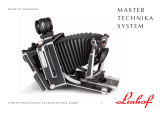
the sides of the panel.
It
will be found easier to remove this viewing hood if
it
is
in
the open position
rather
than
closed.
In
order
to see
the
image
on
the
ground
glass focusing screen,
it
will be necessary to open both
the
front
and
focal plane shutters by setting them to the T
and
0 positions as directed
in
the
sections devoted to those shutters.
To close
the
viewing hood press inward with
the
thumb
and
the
forefinger
on
the
two lower side members
and
upward
on
the long lower section. Move
this all of
the
way
upward
into the
back
of the
camera
and then fold the top
door down until
it
latches. See
Figure
4.
In
the event
that
the
top door and its
attached
wings
spring
free, fold
the
lower flap all of the way up, swing the wings in against the top door
and
pull
it
down to latch. Upon release, the hood will
spring
open properly.
The
ground glass focusing screen will make
it
possible to
check
the
sharp-
ness of
the
image by moving the lens forward
or
backward by means of the
focusing knob on
the
bed
of the camera. Closing the
diaphragm
from the full
open position will also
make
it
possible
to
determine the
depth
of field which
will be included
in
the finished picture.
After
ground
glass focusing has
been
accomplished, lock the sliding
track
with the
track
lock mentioned before.
Remember
to close
and
cock the
shutter
which is to be used for
the
making
of
the
picture before
inserting
the film
attachment
into the camera.
Vi
ew
find
ers
Composition of
the
subject
matter may be accomplished by
anyone
of
three
different methods with
the
GRAPHIC
cameras.
The
ground
glass focusing screen
has already been discussed.
Your
Pacemaker
GRAPHIC
has two types of viewfinders,
either
of which
may be used when
it
is
inconvenient to
refer
to the
ground
glass.
Viewfinders
in
general should not
be
relied upon to give
an
exceedingly
accurate indication of the
amount
of
subject
matter
to be secured
on
the
negative, since the
amount
of subj
ect
matter
which will be seen depends largely
upon the position
at
which
the
observer holds his eye- a
factor
which varies
considerably between individuals
and
is greatly influenced by whether
or
not
the
user wears glasses.
The
optical viewfinder is often preferred in
order
to
define the limits of the field since this finder may
be
fitted with masks of
different sizes. However,
many
photographers
prefer
the
open framefinder for
all types of photography .
rather
than
merely for action photography. Both
finders are used
to
best advantage when the eye is held as close
as
possible to
the
rear
element.
8





















